The very bloody history of old San Juan: The Heroes and Pirates of Puerto Rico
Back in September/October I spent several weeks in the Caribbean with over a week alone in old San Juan Puerto Rico. This is something I have wanted to do for a very long time. During my quarter century career in the US Army I came to have a great admiration for Puerto Rican soldiers and their families. Some of my best soldiers during several commands (platoon and up) were Puerto Rican. Puerto Ricans are some of the proudest American patriots you will ever find. They were always reliable and honest. They always held themselves to a high standard and took pride in their appearance, conduct and work. I have come to find in my time spent there that my assessment fell short. Not only are Puerto Ricans everything I had always known but much more. These people have a warmth, kindness, friendliness, helpful attitude and nature that goes appreciably beyond most other peoples I’ve met in my many travels around the world.
I ran into a lot of mainland North American tourists while in San Juan. I talked to quite a few and was disheartened to find out why most of them were there – in short, to party. They had little idea of the many rich cultural places that surrounded them and would simply comment – “uh the fort looks cool – maybe I will check that out sometime”.


Let me tell you folks that San Juan is a time machine. It possesses an almost direct link to a veritable who’s who of some of the most interesting historical personalities you could ever find. In this article I hope to raise your eye brows a little concerning just how many interesting pirates and personalities have had dealings with Puerto Rico over the centuries. Many of you will instantly recognize some of these great names.
San Juan is an incredibly rich historical place that would require years of study to fully appreciate and understand. Only having a week there I focused on the historical sites and museums. I made many new friends on this trip and they taught me a great deal. The recommendations on what to see next, where to find the history and places I was looking for, where to eat, where to get the best coffee, where to see the best art, etc. pulled me into numerous long historical discussions with San Juan natives who were both impressed with my historical knowledge of their own city and culture, but also eager to teach me more – elated that I was so educated and interested in their rich history. In this pursuit I could not help but make good friends.
For clarity sake I am going to break this article into several parts. Originally I was going to write a strictly historical article. But after experiencing everything I did (and not wanting to write an actual book about this fascinating place and its role in history) – AND also wanting to relate my great experiences in the process, I will write a series of articles which will be released in quick succession. I will cover the history up front, then focus on pirates, and last focus on the tourist experiences/exploration culture/food – *NOTE: the food was so good that I can’t NOT talk about it. LOL
PART I: My personal exploration of the History of old San Juan Puerto Rico

Puerto Rico was claimed by Spain in 1493 and explored during the early years of Columbus’s expeditions. However the city of San Juan was not actually founded until 1508 and originally called Caparra. The earliest manifestations of the town’s first defensive fortifications called La Fortaleza were not completed until 1528 and still stand as the official governor’s residence – the oldest in the western hemisphere. In addition, there is a tower in the center and down in the belly of old Morro Castle itself that is from the same time-frame. This tower probably originally stood as a lone watch tower before King Charles V of Spain designated funds to be used for the construction of a larger fortress citadel and surrounding curtain walls to be built atop the heights there in 1539. I will talk more about that later.
In 1587 the engineers Juan de Tejada and Juan Bautista Antonelli drew up plans for a much grander plan of fortifications for the heights and city which resemble many of the other conventional Spanish fortifications of the time. However, these drawings were never fully implemented because of key changes to the plan which would came later out of necessity and be redrawn and supervised by the great Irish soldier and engineer Thomas O’Daly one of the “Wild Geese” who had learned his trade fighting the English. O’Daly’s changes to Antonelli’s original plans were to ensure the weaknesses exploited during the last Dutch attack, would never happen again. So the fortress itself was not only expanded, but the outer curtain wall was extended as well – in order to encircle the entire island upon which the old city of San Juan was built upon.
El Morro, meaning “the bull” because of its shape in roughly the triangular form/shape of a bull’s head would become one of the most famous fortresses in the world and a lynch-pin in a string of Spanish fortresses in its New World possessions. These forts would be the key in defending Spanish Imperial interests in a long enduring struggle against Spain’s colonial competitors and enemies. San Juan’s large natural harbor and island location made it a naturally defendable town and throughout its history it was attacked numerous times. San Juan was often the first and/or last stop into and out of the New World for many Spanish travelers, as well as incoming immigrants.
The story of San Juan’s growth and that of its fortifications is a fascinating study in adapting to the threat and circumstances of formerly turbulent times which too often touched the city and its inhabitants directly in a very brutal way. In exploring old San Juan and her fortresses one can witness this history very tangibly and as clear as your own hand in front of your face if you will allow yourself moments of contemplation and imagination – as you peel back the pages of history and understand what happened there upon the very place you stand. You can almost picture the events before you and I often wonder to myself what the stones would tell me if they could communicate concerning the things they’ve seen during their lifetimes.
San Juan’s first governor was none other than the famous Juan Ponce de Leon of fabled “Fountain of Youth” fame. I wrote a short little article on him a few years ago. Take a look HERE. LINK I was thrilled to see his tomb during my visit. This guy got around even in death. The poor man died in Havana from infection and poison caused by an arrow he received from a Florida native during their attack on his fledgling colony there. After his death he was buried in the church in Havana, Cuba, but later the residents of San Juan wanted his body returned home. He was next interred in the old church of San Juan which dates to 1511 and is the oldest church in the western hemisphere. A beautiful building from the outside, but unfortunately it was closed for renovations so I was unable to take a look at the old frescoes – next time I suppose.
A newer and larger cathedral was erected in the 1540s, The Cathedral of San Juan Bautista. Upon completion, Ponce de Leon was moved into his final resting place – a fine carved marble tomb in the new Cathedral. I was quite impressed. Although San Juan was teeming with tourists, we were virtually alone in the Cathedral for the hour I was there. A few locals were quietly praying as I reverently poured over every detail of the tomb and church. Here are some pictures:
Outside of town one can also still visit the foundations of Ponce de Leon’s house.
While Aztec gold was being looted in Mexico and their sources of wealth unveiled – rich gold mines quickly occupied by eager Spaniard opportunists – a great discovery was made simultaneously in Peru. It all started with a native Peruvian Indian called Hualpa falling off of an old mountain trail while hunting deer. As he pulled himself back up onto the trail, he grabbed onto a small shrub-like tree to pull himself up and part of it pulled out of the ground. There in the roots of the tree and the hole it came out of were numerous large clods of silver ore.
The native peasant began purchasing more than usual over the next several weeks as he visited his tree numerous times and people noticed. His friends turned him in to the Spanish soldiers who questioned him and he gave up his secret in fear of torture by the Spanish magistrate. The Spaniards subsequent excavation around the little tree soon proved to be one of the greatest discoveries in history.
To this day, the great Potosi silver mine (now in Bolivia) has given up more silver from the bowels of the earth than any other place in the world. The resultant silver trains northwards to move the silver back to Spain became famous and within a few decades a glut of silver changed the value of currency in the old world. Before Potosi was found, gold and silver were of similar value in the old world. A few decades later and silver’s value had dropped markedly and more coins were minted in silver than any other precious metal.
Soon silver trains (convoys of heavily laden donkeys/asses and horses) were making their way north. The combined treasure of these land convoys coming from Peru, convoys coming from the gold mines of Mexico and the convoys coming from Acapulco with the silks, spices and riches of the orient from the Manila galleons, would all converge first upon Porto Bello and then Vera Cruz so that the ships could join together into a massive Treasure fleet in order to bring these great riches back to Seville together.
Many mishaps would cause these great fleets to be diverted – late loading, waiting for or meeting other ships/convoys in pre-appointed places to join them, storms, and lastly – greedy and threatening interlopers wanting to seize the treasure for themselves – PIRATAS! The fleet (in part or whole) occasionally put in at San Juan numerous times historically (though it was not on the traditional route back to Spain) in order to take on water, provisions, and mail for the final journey to Spain. In general, no one person other than high ranking officials, and no cargo was allowed off of the ships when they stopped there.
It had already taken them months to load and have everything correctly inventoried in triplicate. Officials were paranoid treasure would be offloaded and great pains were taken to prevent this. When the fleet finally arrived at Seville, sometimes it took months to again verify that all of the cargo was accounted for. During this time no one was allowed off of the ships and victuals and wine were brought daily during their often long wait.
In 1592 a massive Portuguese treasure ship – the Madre de Deus – was captured by a group of English captains off the Canaries on its final homeward approach. When the ship was docked at Dartmouth it shocked not only the town but the entire country. People came from far and wide to see the great spectacle. It not only dwarfed any ship the English had yet built, but its hull and superstructure alone stood stories taller than any buildings in the town.
Royals from London came down to look upon the ship and merchants from Amsterdam came to marvel at its size and buy portions of its cargo. The riches on this one ship made up the better part of the entire income of the English treasury in a years time. The ship made such an impression on the locals, merchants and royals alike, that plots and ventures both illegitimate and government sponsored to go after more such rich prizes were soon undertaken in both England and Holland.
The roots of the Guinea, London and East and West India Companies can be traced back to this single event. Many attempts were made to seize more of these great treasure ships and the greatest prize of all would be to take an entire treasure fleet together. There were many attempts and many tried – but few succeeded.
The famous poem about Grenville’s Revenge “The One and Fifty Three”, is one such failed attempt where we find Admiral Howard’s fleet sailing to intercept a returning Spanish Treasure Fleet in the Azores. They spied a large amount of sail on the horizon and set course to intercept their rich quarry. However, rather than running into the treasure fleet, they stumbled instead upon a large fleet of Spanish War Galleons that King Phillip had sent to escort the incoming treasure fleet to safety.
In the ensuing battle the English were completely outmatched and had to run for their lives. Sir Richard Grenville stayed behind in a perpendicular line to the Spaniards peppering their advancing horde of 53 ships and then the Revenge took them on single handed – holding them off for hours to allow Howard to make his escape. The Spaniards took possession of the dismasted English warship with only a handful of survivors remaining alive.
Usually if English or Dutch privateering squadrons encountered a Flota, they would not have sufficient force to bag such a large prize and so made themselves content with just being able to cut out a single straggler from the main convoy and there are a number of such historical anecdotes of this occurring.
THE ENGLISH
In 1595 the infamous English gentlemen of fortune Sir John Hawkins and Sir Francis Drake were given orders to find and seize a treasure fleet by Queen Elizabeth herself. These men who were kinsmen in the first place had become both rich and famous in their daring exploits. Old Hawkins had led the navy board for some years approving all naval funding, building and procurement. Drake had circumnavigated the world – the first Englishman to do so. Their first venture together almost thirty years before in 1568 ended in disaster at the battle of San Juan de Ulloa where they both barely made it back to England alive. I wrote a short story of historical fiction about it here. LINK
This was a well manned and supplied but very clandestine mission with the Queen herself supplying intelligence to the pair. Unfortunately the two ran into the same problems and could not locate the treasure flota. Their own flotilla consisted of some impressive vessels. Twenty seven ships with 2,500 men total were assembled – and at least half of them were large two decked English Race built War galleons of between 600 to 800 tons. During their foray into the Caribbean it was learned that a storm had scattered the flota and many of the treasure ships were damaged. The flagship or Almiranta of this fleet, the largest, most heavily armed and most heavily laden treasure galleon had lost her mainmast in the storm and put into San Juan Puerto Rico for repairs, protection, and to await orders to join a subsequent convoy home to Spain.
This was a rich enough prize to lure Drake and Hawkins into attempting an assault upon San Juan to seize this galleon and its treasure. However, Spaniards had heard about and even encountered this English expedition in the Canaries where they stopped to resupply – and rumors of warning made their way to San Juan. The Spanish governor of Puerto Rico and the Admiral of the Flota, Gonzalo Mendez de Cancio (who BTW was also the Spanish Governor of Florida) was alerted that the English were on their way and before the expedition arrived, the Spanish removed all of the treasure from the crippled Almirante galleon into the fort. Because of the extensive damage she had sustained in the storms, a decision was made that the ship would be better used to attempt blocking the passage into the harbor. So the large damaged flagship and one other aging galleon were sunk in the passage to prevent English entry. It didn’t work.
The English fleet arrived at San Juan on the 22nd of November and took up a position in line off the north eastern shore of the San Juan islet. Landing troops at the Ensenada del Escambron proved impossible with choppy waters and the rocky cliff-like shoreline. *NOTE: The fortifications/”castle” of San Cristobal occupies the space above the heights just to the west of there now, but was not yet built at the time. The Spaniards wishing to deny the English the safety of the masking cliffs, hauled several large artillery pieces to the cliff tops and began to bombard the English ships below.
The Spanish gunnery was quite effective and forced the English to move off shore to regroup. In numerous Spanish historical sources, they believe that this bombardment killed Sir John Hawkins. However, from my own detailed analysis of the English accounts which several naval historians say were verified from original logs, Hawkins was already very sick and near death. Several of the English accounts say that he had already expired by the time the Spanish launched the first volleys of their bombardment.
The following day Drake decided to boldly sail into San Juan Bay with the intention of sacking the city and taking the treasure. However, Spanish gunnery from the two forts (La Fortaleza and an earlier manifestation of Morro Castle on the heights) as well as five Spanish galleons in the harbor proved much more damaging and costly than the English had anticipated. A stalemate ensued making it almost impossible for Drake to attempt troop landings – turning into a hotly contested gunnery duel in which the Spanish lost one of the Galleons and the English eight of their own.
During the English retreat an additional two ships were lost. Some Spanish accounts say the English lost 12 ships in all and some English accounts state eight total were lost. A few of the Spanish accounts also say Drake himself landed with troops and was wounded in the fracas before retreating. *NOTE: I not only found a very old account from a history of San Juan in Spanish from the early 19th century which states that Drake and one of the Spanish officers – one Pedro Suarez Coronel – actually personally exchanged swordplay, with Drake wounded in this duel! Interestingly enough, a local historian also told me the same story when we were discussing the English attack. FASCINATING!
Although English narratives of the battle are impossible to find, I tend to believe myself that the Spanish narrative is true and that Drake did indeed force a landing and made attempts on La Fortaleza. My reasons for this are simply the documented casualties which were incurred and are entered in historical contemporary documents. The estimates put Spanish casualties at 40 to 50 killed and many wounded, and English casualties at 4 to 5 hundred with many wounded. I do not believe that a combined Spanish battery of 70 to 80 guns on shore and upon the galleons would have inflicted 400 to 500 casualties upon the English unless a ground assault were attempted.
At any rate, Drake escaped and ordered a retreat. The English subsequently moved upon Panama to try their hand at raiding the area and to attempt bringing some sort of profitable outcome to the expedition. Drake himself died of dysentery during this failed Panama incursion. Both Drake and Hawkins were buried at sea after the battle at San Juan. Some of the old Spanish accounts like to claim that the wound Drake received at San Juan is what actually caused the infection which led to his death two months later on 28 January. An interesting death anecdote has it that Drake knew it was his time and asked for help in putting on his breastplate and helmet so that he could meet death as a soldier. This is the only recorded account of a burial at sea I have ever read where he was lowered into the ocean in a lead coffin. Thus ended the life of the illustrious Sir Francis Drake.
The English were not yet finished with San Juan. Three years after Drake’s attempt, another much more successful English invasion of Puerto Rico was launched in 1598 by Sir George Clifford, the 3rd Earl of Cumberland. It is amazing to me why Clifford is not better known today. He was a superstar in his own time. He was not only the Queen’s own champion and one of the best tournament jousters in the world, he was also a very rich and famous man – made so in his daring exploits mostly against the Spaniards and Portuguese. Indeed, he was the leading captain who captured the great treasure ship Madre de Deus that I mentioned earlier which really began this trend of obsession in going after treasure ships and treasure fleets.
When word of Hawkins’ and Drake’s death got back to Queen Elizabeth she was both shocked and outraged. She wanted revenge as soon as possible and her own Champion Sir George Clifford volunteered to lead this new expedition. Clifford had used some of the profits he gained from the Madre de Deus to build his very own warship. This ship named “The Scourge of Malice” (later renamed the Red Dragon after Clifford’s death) was not only larger (at 600 tons) and better armed than Drake’s Golden Hind with 38 guns, but I firmly contest enjoyed a much more illustrious career than Drake’s favorite ship.
It is a mystery to me why there are not models of the Scourge of Malice available in kits or why it is not made mention of even more prominently than the Golden Hind. I can only guess that the Hind’s place as the first ship of English circumnavigation could partially be the reason – or that it possibly could be some kind of anglophile disdain for the Red Dragon because of her loss to the Dutch which makes her less prevalent in the history books. I don’t know – and it’s beyond the scope of this article, but I would highly encourage my readers to look into the grand career of the Scourge of Malice/Red Dragon. This is the only illustration I could find of her.
In Cumberland’s attack, the Englishmen were landed well beyond the line of fire or in view of the town itself, twelve miles east, on 16 June 1598. With twenty ships and 1,700 men, the English marched through the night and made an initial unsuccessful foray into the San Antonio bridge. Shadowed by some of their own ships along the coast, they were soon reinforced with boats and were able to out flank the Spanish defenders in a crossfire from two directions causing them to break and flee into El Morro. The English met little resistance as they assaulted the town and artillery was landed to bombard Morro Castle. As the siege of El Morro began, the English sacked San Juan itself whose citizens had mostly retreated into the castle as well. After thirteen days of bombardment, the Spaniards surrendered the fort and city to the English on 30 June 1598.
The Spanish surrender occurred so easily due to a couple of simple reasons. First, the fort which was much smaller at this time was so over crowded that dysentery and sickness soon spread through both the soldiers and citizens tightly contained within. In addition, with Cumberland sacking and occupying San Juan itself, the Spaniards were soon out of victuals to feed the over crowded population within the fortress.
The English victory was short-lived however, because the very dysentery and sickness which had spread through the Spaniards now made their way through the English ranks, incapacitating between a third to a half of his force. Cumberland knew with so little men, he could not hold onto the place and because the expedition had been an endeavor of revenge to begin with made preparations to leave. He dismantled all of the forts artillery and had it loaded aboard his ships right along side the cathedral’s bells. He also stole architectural marble and the church’s own organ. He ordered all of the surrounding fields and crops burned and seized some 2,000 slaves.
This English looting of San Juan occurred throughout the months of August and September and Cumberland left with about half of his force on 14 August 1598 and was followed by the remainder on 23 September. Puerto Rico which literally translated means “Rich Port” or “Port of Riches” was no longer rich at all. The plundered shell of San Juan was abandoned back to the care of the Spaniards – who were determined that Cumberland’s success would never again be repeated. They would be ready the next time.
Sir George Clifford returned to England a conquering hero and great festivals and banquets were held in his honor. He had achieved revenge for the Queen and avenged the loss of Hawkins and Drake. Cumberland had satisfied English pride. Sadly this great wealth and honor would be short lived. Like many sports and celebrity superstars of today, Cumberland was an idiot with his money. His lavish lifestyle, gambling on horse races and jousting led him to sell off his own ancestral lands in order to satisfy his debts. Although in his 40s, his own guardian and Father-in-law, Francis Russell had to take control of his estate and ended up owning the Scourge of Malice in the juggling of his assets. He died only a few years later in 1605.
The Kingdom of England and the “English” would attack the island one more time during a small incursion with two warships at Arecibo in 1702 (about 90km west of San Juan). The English were repelled with heavy losses and their captain killed by the famous Puerto Rican captain of militia Antonio de los Reyes Correa. The next attack involving Englishmen who were by then classified as British(Act of Unions 1707/1714), would be against San Juan once again in 1797 under the later named and still currently known Kingdom of Great Britain. This was the largest most massive attack ever assembled against San Juan or Puerto Rico with 68 British Warships and 13,000 men. This final invasion was handily defeated by the Spaniards with 400 British troops actually surrendering and captured. I am not going to cover this battle in detail as it is out of the scope of my period of exploration/study, the Golden Age, the Age of Piracy, and this website. It was a much different world by then.
THE DUTCH
Spain since 1580 had passed a moratorium against trading with other nations. This long restrictive policy led many other colonial powers to force trade upon Spanish New World ports. It can be said that this was one of a number of causes which led to widespread piracy in the Caribbean. The Dutch forced their way into the New World much more militantly than the English and on a much grander scale. Indeed one of the sticking points that prevented a treaty during the long Eighty Years War between Spain and the Netherlands was open trade. King Phillip would not concede this point to allow Dutch traders free trade or indeed any trade at all in Spanish ports even though a booming illegal trade was already occurring anyway.
Both Spanish towns in Iberia and Spanish colonies in the New World wanted Dutch goods, however, the King of Spain would not give in to this key concession. So the war continued on and the result following the renewal of conflict (after the twelve years truce) was the creation of the very militant Dutch West India Company (WIC) in 1621. The WIC and its aggressive charter can be summed up in the verbiage of its first director-general Willem Usselinkx when he stated regarding the establishment of the companies mission to be: “the means and road wherewith to divert the arms of the King of Spain from our necks, and to cut the sinews by which he sustains his wars in Europe by taking away from him the Indies, little by little; and…. which is more important, our people in the midst of war would receive thereby some respite and profit.”
As a result the Dutch brazenly and militantly began seizing Spanish territory across the New World, from several of the leeward islands, to the ABC islands(Curacao), to numerous colonies on the Spanish Main coastline from the Amazon delta to Surinam. Indeed, Brazil was taken by the Dutch for around forty years. In the year following the seizure of the Portuguese capital of Brazil, the Dutch had also been desperately trying to find and seize a treasure fleet. The Dutch Zee Roovers (pirates and privateers – or – zeerovrij and kaapvaart) had already done very well for themselves seizing hundreds of Portuguese and Spanish prizes – but to find and capture an entire treasure fleet together – that was the prize above all others.
Two Dutch fleets scoured the Caribbean looking for the Flota. One of these Dutch flotillas was led by the hero who took San Salvador, Piet Heyn, whose orders were to find the other flotilla commanded by Boudowijn Heindrikszoon and link up together for greater strength. Heyn who had been following clues given to him by captured Spanish ships, was making his way north when he stumbled into the an actual Spanish Treasure Flota.
The Flota sailed in a tightly packed formation in good weather and was heavily armed with war galleon escorts. It was too big of a bite for the Dutchman to take with the 14 ships under his command. He shadowed the great convoy for a few days hoping to cut out a straggler, but it just didn’t happen and he continued northward to find Hendrikszoon. A despondent Heyn would get yet another chance to bag the greatest known prize upon the oceans only four three later.
An additional captured Spanish prize finally provided the intelligence Heyn was looking for about where the other Dutch fleet was. It was learned that Heindrickszoon had been killed in a battle and that his fleet after sustaining heavy damage had already departed for Holland. This intelligence was flawed, but Heindrickszoon was indeed dead. Even though Heyn’s expedition never linked up with Hendrickszoon or captured a flota, he still considered the venture successful with fifty-five captured Spanish prizes taken back with him to the Netherlands.
A FEW MONTHS BEFORE:
On 24 September 1625 a frustrated Boudewijn Hendrikszoon assembled his 17 warships just outside of San Juan Bay. Hendrikszoon was from a famous Dutch maritime family who would become even more famous in the following decades. It has escaped the notice of most historians, but my research has shown that Boudewijn was the younger and only brother (gebruder) of Evert Hendrikszoon. Evert who was a great Sea Beggar captain in his own right would become the father of the illustrious Evertsen clan in the Netherlands. Very few Dutch families produced so many great captains, admirals and heroes as the Evertsen family did.
Hendrickszoon’s original orders were to bolster and reinforce the defenses of Bahia in Brazil which the Dutch had taken the year before. He entered the bay with 35 ships and learned that the Spaniards and Portuguese had already retaken it. Hendrikszoon did not believe that he could retake the place with the fleet he had, so he completely violated WIC orders – which specified the first priority was the defense of Bahia and the second was the taking of a Spanish treasure fleet. He ordered his fleet be divided into three parts. One would take the supplies meant for Bahia back to the Netherlands, one would raid and seize Portuguese possessions in West Africa, and his own part of the fleet consisting of 17 ships would move north to find a treasure fleet and or attack and seize San Juan Puerto Rico.
WIC orders were very clear in that their captains were expected to harass and seize as much enemy (Spanish) shipping possible and take a treasure fleet if one could be encountered. An additional order was given to seize any Spanish settlements possible in order to expand Dutch interests in the West Indies. The Dutch desired both salt and a port at the north-easternmost approaches into the Caribbean in order to harbor and resupply Dutch vessels coming and going.
Eventually Sint Maarten, Saba and Sint Eustasius would be secured by the Dutch which are to the east of Puerto Rico. The greater prize would have been an already fairly well developed settlement with a town and fortifications in place. Hendikszoon with over 1,500 men believed San Juan to meet this criteria and it was his military assessment that the place could be taken. The Spanish governor Juan de Haro y Sanvitores spread his militia out into several areas hoping to ascertain where the Dutch might land and harass their advance.
Surprisingly the Dutch made no effort to land men beyond cannon range of the fort and instead chose on 25 September at 1300hrs to sail in line – directly under El Morro’s guns into San Juan bay – where they began a suppressing bombardment of the fort and city as they passed and then anchored the fleet beyond its reach in the roadstead off Puntilla Point. They also seized the small fort adjacent to El Morro across the inlet at El Canuelo (see illustration below).
On 26 September the Dutch launched their ground assault and seized La Forteleza. They mounted deep incursions into the city. Most of San Juan’s citizens fled the city into the countryside and some fled west along the islet into the safety of the fortress. Artillery was landed and the Dutch began slowly digging “saps” or trench-lines ever closer to El Morro in order to slowly advance their cannon forward under cover to duel it out with the fortresses cannon. By the 29th the Dutch had occupied the Calvario Heights and emplaced a six gun battery which began firing upon Morro Castle.
Over the next three weeks numerous skirmishes occurred between Dutch raiding parties and citizen guerilla fighters. Several bold attacks were made by the Spanish military forces which sallied forth upon the Dutch siege works from the fortress but they were all repelled. In these attacks the Spaniards managed to significantly harass the Dutch long enough to spike (destroy/render unusable) several Dutch guns at Calvario heights and in the sap-work trench-lines directly in front of El Morro. By the 16th of October the Spaniards even recaptured Calvario heights.
Hendrikszoon called upon the fortress to surrender twice but Haro refused and the Spaniard guerilla attacks became more and more bold. After over three weeks of fighting and occupation, Hendrikszoon knew the resistance was too great and that he did not have sufficient forces necessary to ensure a successful direct assault upon El Morro. His artillery had been ineffective in opening up a breach in the castle’s 18 foot thick walls. His efforts to starve the fortress and bombard it into submission had failed – and his calls for surrender had been refused.
*NOTE: I was told by one of the Puerto Rican historians I met that things are not as simple as the history books tell us. He informed me that the forays out of the fortress to try to break the Dutch saps/trench-line and destroy the Dutch cannon had been unsuccessful – and that many Spaniards were killed in these attempts. Morale was low and the senior officer in command of the fort and garrison wanted to surrender. As he was moving to do so (against Governor Haro’s wishes), the local captain of militia countermanded his orders and stepped in front of the gate to stop him. There was a duel between the two men and the captain of militia – one Juan de Amezquita y Quixano not only won the fight, but beheaded the garrison commander with his own sword right then and there, in order to frighten the garrison’s men into following his orders NOT to surrender.
At any rate true or not true, Hendrikszoon could not force El Morro to capitulate. Knowing that he could not win and that he must lift his siege – and abandon the city, he finally ordered his men to completely ransack the city and burn it to the ground as they slowly retreated back to their ships transferring a great deal of booty and supplies which they had captured.
During this final phase in the operation, Amezquita ordered that the Spaniards sally forth out of El Morro one last time with all of the forces they had remaining. This bold attack led by Captain Amezquita took the Dutch completely by surprise and pushed the remaining Dutch out of their trench-lines, rooted them out of the city, and forced almost a panicked route/quick retreat back to their ships. The Dutch as result left a goodly portion of their captured supplies and booty behind.
A famous painting was commissioned by the King of Spain who was elated that the Dutch had been forced to retire. The painting by Eugenio Caxes still hangs in the Museo del Prado today. (below)
There are many stories about this battle and I loved hearing the local historians and National Park Rangers (some of whom are excellent students of history and historians themselves) tell me their renditions of how this fight happened and where. It was really quite fascinating to be shown the places in person where this fight occurred. I was shown a place in some very obvious “dead-space” (military term for space which is difficult or impossible to observe from one’s position) where the Dutch concealed themselves and made covert attempts to climb the walls in certain places.
There is a very prominent monument which was erected in 1925 to commemorate the battle fought in front of Morro on the “esplenade”. To this day the esplenade remains a large open green field of clear space. This was intentional from the beginning so that the fort would enjoy good fields of fire in a large kill zone that any enemy would have to cross in order to attack or attempt capturing the fortress. The monument was put there to celebrate the 300th centenary of the battle and also to honor the bravery of Captain Amezquita. One of the local historians also informed me that many believe it marks the location of an actual one on one duel between Amezquita and Hendrikszoon themselves. Although I have been unable to verify if this is actually true in any of my sources I was able to find a brief mention of Hendrikszoon being wounded, and that he required assistance to get back to the ships.
It is a peaceful place now. The field is often full of people flying kites. As I took everything in, I looked at the place where the Dutch retreated down to their boats under fire and imagined the impressive Dutch warships in the harbor exchanging gun fire with the fortress. Once the Dutch got back to their ships they moved again to their previous position in the bay out of range of the fort and began a sporadic bombardment of the town. They waited there for over a week and some historians have stated for unknown reasons. Its quite obvious to me that Hendrikszoon was waiting for a good wind so they could make their exit under the fort’s guns with as little damage possible. In addition with many wounded, it was much easier for surgeons to remove lead fragments on an anchored ship than on a moving one. Repairs and preparations were also undertaken and I believe the Dutchmen felt safe aboard their ships knowing that the Spaniards could not muster enough strength to threaten them there.
When they finally made their exit from the harbor on 02 November 1625, a fierce gunnery duel again erupted between the warships and the fortress. One of the mid sized (450 ton) Dutch war-frigates(fregat) Medemblik ran aground on the way out of the channel. Dutch attempts to get her free again were futile. Another ship was also heavily damaged while assisting the Medemblik – rescuing her crew and some supplies under constant gunfire from Morro. One account relates that the Dutch left a second damaged ship behind.
Captain Amezquita who was now the hero of the battle, ordered his men into boats and rowed out to the Dutch warship to capture her. He got there just in time to put out the fuze which was about to light the gun-powder magazine afire to destroy the ship in order to prevent it from falling into Spanish hands. Amezquita was able to refloat the Medemblik and upon returning to shore found out he was the senior officer in charge of San Juan and El Morro. Governor Haro had been severely and mortally wounded by Dutch cannon-fire and became bed-ridden. He died a short time later. Amezquita was a hero, but San Juan was a smouldering ruin.
The Dutch moved their fleet west to San Fransisco Bay to make repairs in a safe anchorage and to tend the wounded. After tallying up losses Hendrikszoon had lost over 200 men. The wounded Dutch commander could not return to Holland unsuccessful and still had a large army ready for action, so he sent a squadron of ships forward on a privateering raid around Santo Domingo while the remainder of the ships continued repairs for the following month. Attempts to forage and bring back water were met with stiff resistance from the local Puerto Rican inhabitants of San Germane who watched their every move. Their privateering squadron returned having successfully taken several prizes and Hendrickszoon made the decision to send two of the Dutch warships Koninginne Hester and Jonas home to the Netherlands loaded with the loot they had taken and with all of the prize ships that had been captured(they arrived back in Holland in May of 1626). Hendrickszoon’s remaining fleet of (13 or 14) warships set out for Margarita where they successfully took the Spanish towns of Pampatar and Porlamar.
Still not satisfied with the loot taken, Hendrikszoon headed north for Havana hoping to find a treasure flota. He cruised outside of Havana for over a week sizing up its defenses and making strategic drawings for the WIC investors/lords (Heeren XIX) to consider for a possible future expedition of conquest. He considered attacking himself but knew with his fleet’s depleted size and manpower, that it would be too risky to try. The Dutch headed south to the Bay of Matanzas where they reprovisioned the fleet and prepared for the journey back to Holland. There Boudewijn Hendrickszoon fell ill and died. It is ironic that the place of his death would be the same exact place where Piet Heyn would capture the entire Spanish Treasure Flota intact only three years later – the only man in history to capture an entire Spanish treasure fleet. Hendrikszoon’s fleet only had 700 men still alive out of the original complement of 1,500 men.
Aaron R. Shields, a.k.a MK
by modernknight1 with no comments yet.















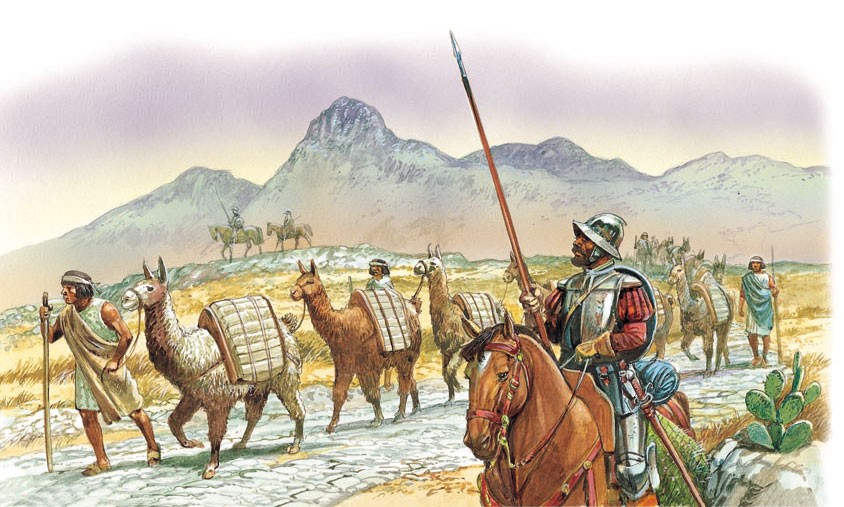


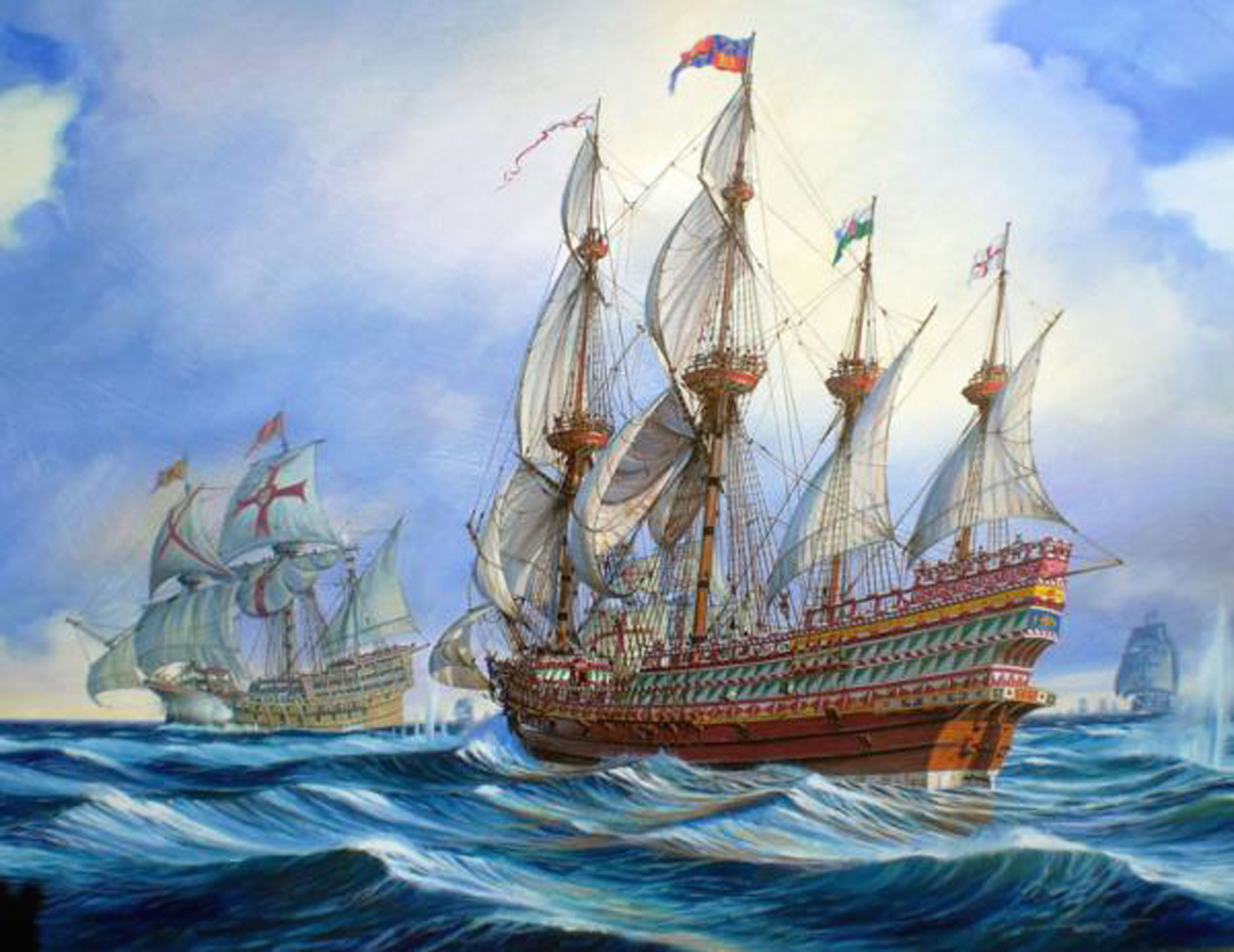
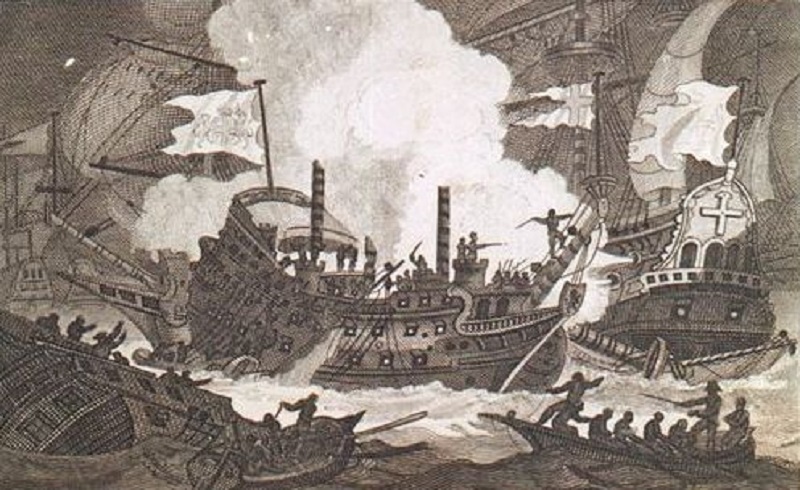
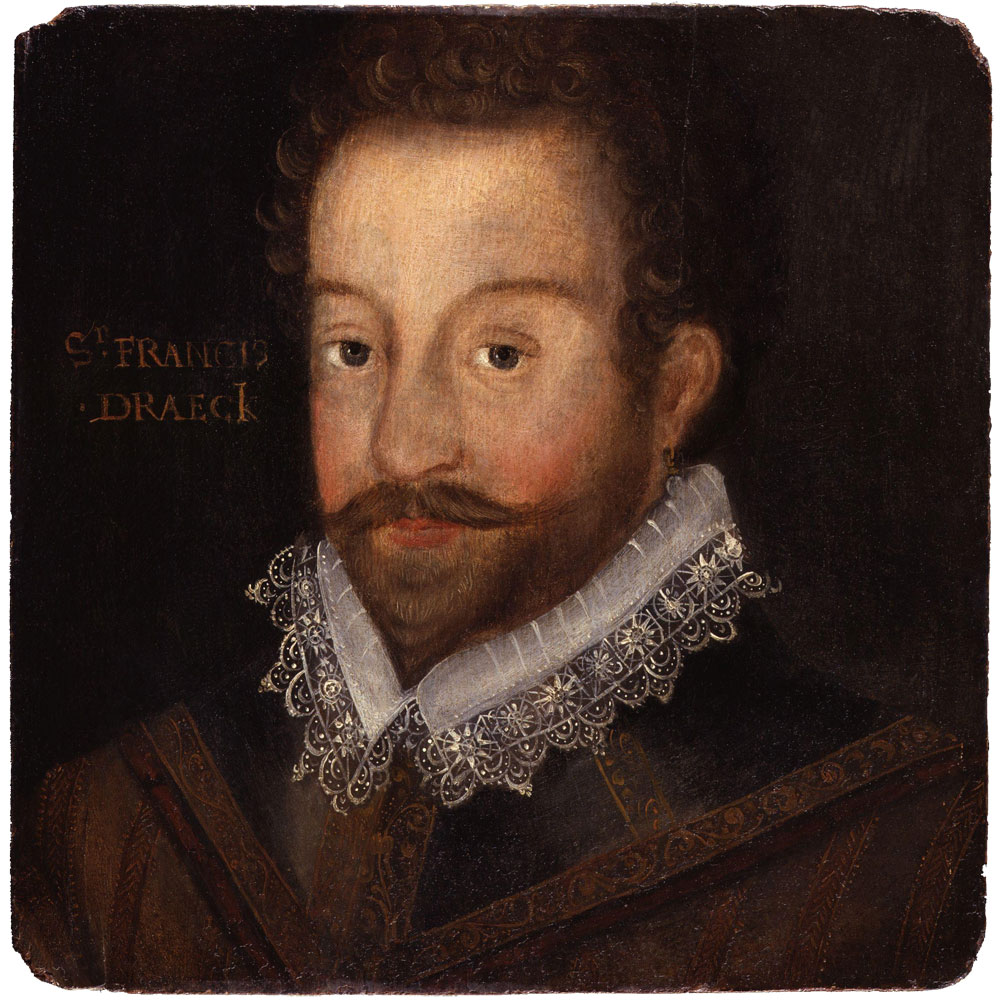
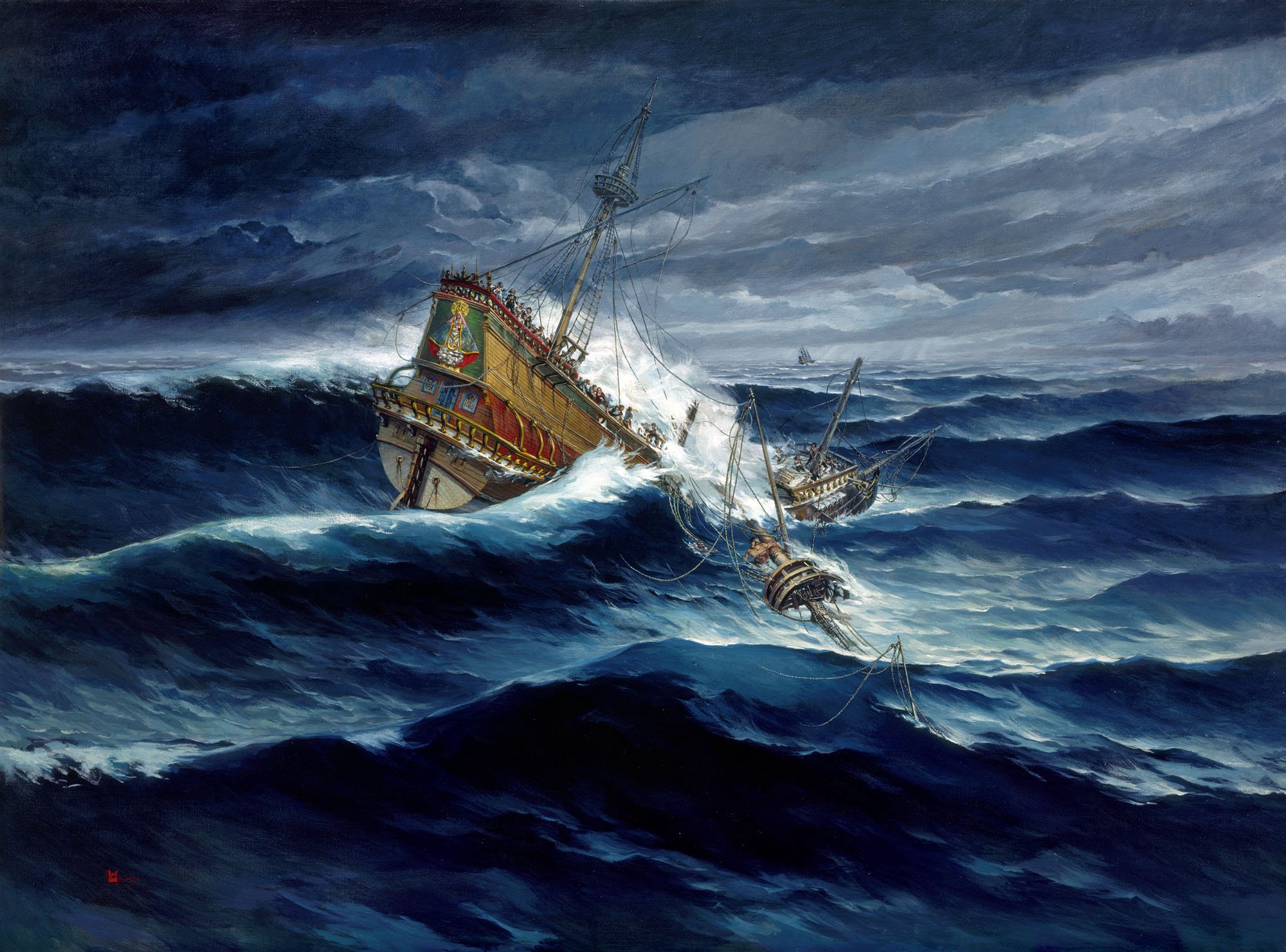


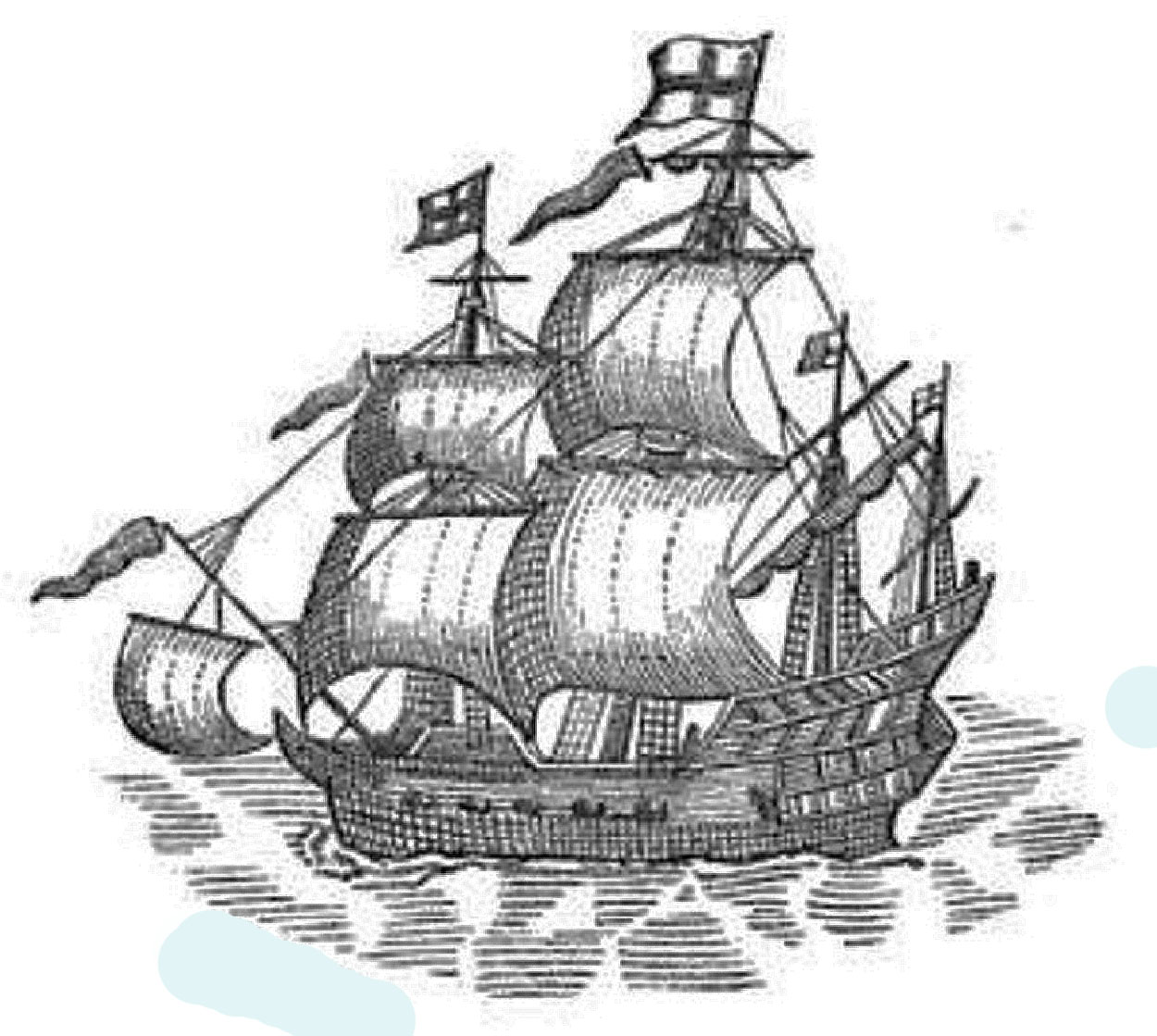


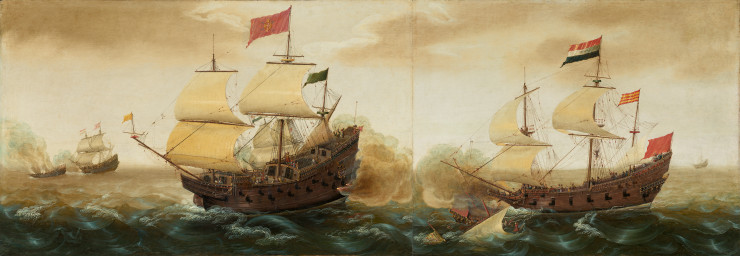























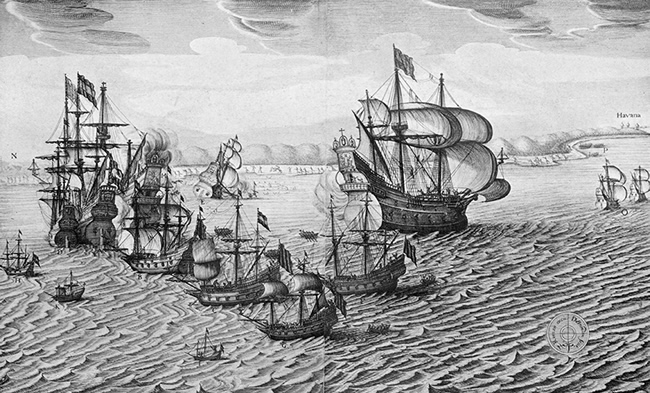

Leave a Reply
You must be logged in to post a comment.